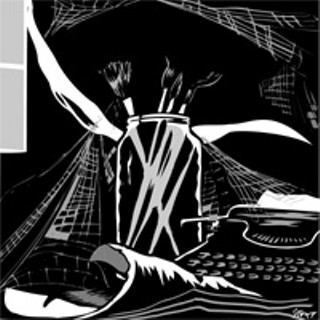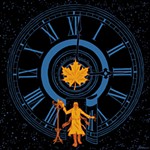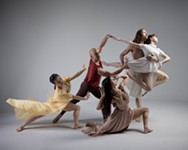Letters at 3AM
States of the Art
By Michael Ventura, Fri., Jan. 10, 2003

Our "best-of" lists in the last Chronicle concurred that 2002 was an exceptional year in cinema. (My list neglected the unusually honest We Were Soldiers and Diane Lane's fine work in Unfaithful; since my last deadline I've also seen The Hours, a stunning experience.) For the first time in a long time it's felt important to see movies -- important in the sense that nothing in the universe is a one-way street. A kind of magic exists between a work of art and its viewer or reader or listener. The work of art absorbs the qualities of attention that it's given. Each artwork is a repository, a container, a well; when loved, it absorbs and stores that love and passes it on. That's what it's for. (Art began with the rituals of shamans, after all.) This isn't a matter of numbers but of intensity; sacred energy doesn't depend upon mass approval for its effect.
But we don't yet know whether 2002's cinema was a flash of lightning in a dark age or the advent of a new vigorous era. Whichever it may be, 2002's vitality in film underscores the dearth in our other arts. For there is no question that, in general, America's arts have fallen from grace. To gauge how far they've fallen, go back 40 years to 1962.
Cinema, in 1962, saw David Lean's British-American Lawrence of Arabia, John Frankenheimer's The Manchurian Candidate and Birdman of Alcatraz, Sidney Lumet's Long Day's Journey Into Night, Stanley Kubrick's Lolita, Sam Peckinpah's Ride the High Country, John Ford's The Man Who Shot Liberty Valance, Orson Welles' Mr. Arkadin (U.S. release), Robert Aldrich's Whatever Happened to Baby Jane?, and lesser but memorable works by Peter Ustinov (Billy Budd), William Wyler (The Children's Hour), Frank Perry (David and Lisa), David Miller (Lonely Are the Brave), Mervyn Leroy (Gypsy), John Cassavetes (Too Late Blues), Arthur Penn (The Miracle Worker), Don Siegel (Hell Is for Heroes), Otto Preminger (Advise & Consent), Vincente Minnelli (Two Weeks in Another Town), and Sam Fuller (Merrill's Marauders). Foreign films were represented by Tony Richardson's A Taste of Honey and The Loneliness of the Long Distance Runner, Michelangelo Antonioni's Eclipse, and Ingmar Bergman's Winter Light.
Music, 1962: John Coltrane, Charles Mingus, Miles Davis, and Ornette Coleman were at their peaks. Duke Ellington, Thelonious Monk, Louis Armstrong, and Coleman Hawkins were still doing masterful work. Bob Dylan wrote "Blowin' in the Wind" and "Hard Rain's A-Gonna Fall." Joan Baez sang like an angel, and Pete Seeger was the conscience of American song. Elvis Presley, the Shirelles, the Marvelettes, Roy Orbison, Mary Wells, Ray Charles, and Booker T. charted quality Top 20 hits. The blues were played by Muddy Waters, B.B. King, and Howlin' Wolf. Country & western was represented by Patsy Cline, Johnny Cash, and Loretta Lynn. Frank Sinatra, Ella Fitzgerald, and Nat King Cole were never better. Tony Bennett, Judy Garland, Dean Martin, and Bing Crosby were recording. The Broadway musical was at its healthiest. All together, they constituted a flowering of music unmatched for variety and depth by any time or place in history.
(And across the Atlantic, in Liverpool and Berlin, the Beatles applied the great tradition of the English music hall to American music and were fixin' to astonish everyone.)
Literature, in 1962, included a masterpiece of the novel, Joseph Heller's Catch-22, and a masterpiece of theatre, Edward Albee's Who's Afraid of Virginia Woolf? The year also saw Tennessee Williams' The Night of the Iguana and Ken Kesey's One Flew Over the Cuckoo's Nest. In poetry, six old men and one old woman were our pillars: William Carlos Williams was writing the last of Paterson, Ezra Pound was writing the last of his Cantos, T.S. Elliot was still an authority, and the quintessentially American voices of Carl Sandburg, Kenneth Rexroth, Marianne Moore, and Robert Frost were still loud in the land. E.E. Cummings died that summer, after writing his final poem. Sylvia Plath was composing Ariel, and Anne Sexton, Robert Lowell, Kenneth Patchen, Robert Creely, Denise Levertov, Allen Ginsberg, Robert Bly, James Wright, Amiri Baraka, Alan Dugan, and Charles Olson were writing poems in a wide spectrum of styles. Philip K. Dick, Jim Thompson, and David Goodis were alive and kicking (really kicking). So was Nelson Algren. Jack Kerouac had one novel left in him. (If you want to include Saul Bellow and John Updike, that's your business.) Henry Miller was finally in wide publication (after decades of censorship), and so was William Burroughs. Thomas Pynchon was about to publish V. James Baldwin, Susan Sontag, and Norman Mailer were expanding the boundaries of the essay.
(Footnote: If you've been to college and are still unfamiliar with most of those names, your educators have short-changed you. Demand a refund. And scrounge up those books.)
The painting of 1962 saw Andy Warhol's Green Coca-Cola Bottles and Marilyn Monroe.
Television, 1962: Stirling Silliphant's Route 66, Howard Rodman's Naked City, and Rod Serling's Twilight Zone projected into our living rooms an existential sense of character that was equal parts jukebox and Shakespeare. On radio, Jean Shepherd nightly broadcast the most adventurous 50 minutes in the medium's history. In nightclubs and on recordings, Lenny Bruce and Lord Buckley were transforming the nature of stand-up comedy.
Genius was afoot. Everywhere in our arts, genius was afoot. Variety seemed inexhaustible. These artists worked in the faith that America could still be America and fulfill the dreams of Jefferson, Whitman, and Lincoln. They expected great things of us. Not "great" in the sense of power, but great in the sense of depth, inclusiveness, and justice. Our artists were calling us to adventures of the heart and mind. That sense of the call is what transmutes art into history. Our answer to their call can be summed up in those two misused, misapprised words "the Sixties," with that era's lasting achievements of the civil rights, anti-war, and environmental movements and the liberating energies of feminism and gay rights. Nothing less than the definition of "human being" was challenged, changed, and expanded -- so much so that the 30 years of reactionary politics since has not been able to erase the change.
But the reactionary elements in politics, economics, technology, and culture have taken an awful toll. With rare exceptions -- like 2002's blossoming of cinema, the almost-underground movement of poetry jams, and various local music scenes (L.A.'s in the Eighties, Austin's off-and-on for the last 30 years) -- American art has never been more marginalized, ghettoized, and controlled than it is today. Many painters and writers hide in academia and speak mostly to each other. All over the country, outstanding visual artists are confined to tiny galleries and craft fairs; the major arts organs and museums never hear of them. Corporate publishing effectively bans any novel that doesn't sell well in its first weeks on the shelves (which would have doomed, say, Catch-22, a novel that was all but ignored for the first year of its publication). The corporate stranglehold on music has driven most good stuff back into garages, small clubs, and independently produced CDs that get little distribution. (Even excellent reviews and publicity couldn't get the Flatlanders' 2002 album onto mass-market radio.) Today, more than in any era of American history, it takes exceptional courage and endurance for any artist to work through every stage of his or her life. The odds against us are immense. There is precious little exchange between artist and audience. Burnouts are legion.
But as Isak Dinesen wrote in Babette's Feast, "An artist is never poor." (If you require proof of that, check out Lisa Mednick's incandescent 2002 CD, Semaphore.) In a time like ours, the lonely responsibility of the artist is to proceed no matter what, trusting that someone will listen to, value, and extend what you sacrifice to achieve. The responsibility of the viewer, reader, and listener is as great: to heed art's call and respond with a commitment comparable to what is required for art's creation; only then is a bond joined between artist and public that creates history and further extends the definition of "human." Otherwise, history -- and what it means to be a human being -- is left to the businessmen and politicians. As the Greek poet George Seferis said: "We do not speak anymore of the major or minor artist, but of who keeps art alive." I write this to salute artists who brave the difficulty, keeping art alive for the day when the call can once more be heard. ![]()








